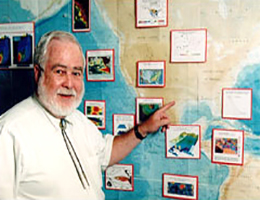
Florida State University does not have a crystal ball, but it is developing a new tool that could possibly see the strength of future hurricane seasons.
The National Oceanic and Atmospheric Administration (NOAA) has awarded the FSU Center for Ocean-Atmospheric Prediction Studies (COAPS) a $6.2 million, five-year grant to support the development of a model that may more accurately predict the number of hurricanes in an upcoming season, according to COAPS director emeritus James O’Brien, the Robert O. Lawton Professor of Meteorology and Oceanography and state climatologist.
"It’s important for people, especially in states like Florida, to know how weak or strong the hurricane season will be," O’Brien said. "That’s why the government is investing in this. Emergency managers and citizens have to make a lot of decisions regarding preparedness that can been helped if they know it’s going to be a particularly bad season."
The new model will use the university’s supercomputer to amass atmospheric, ocean, land and climate data to predict the intensity of the hurricane season. Currently NOAA experts and the University of Colorado’s William Gray use sea surface temperatures and statistical methods to develop long-range hurricane forecasts, according to O’Brien. The accuracy of these predictions have been mixed.
"We want to use big, huge computer models to see if we can’t beat that method," he said. "The outcome would be perhaps a more accurate estimation of how many tropical storms we can expect in a season and where they will form. People would like us to say there are going to be 12 storms and then there are 12 storms."
Whether the new method will deliver that kind of precision will not be known until after researchers begin running data from previous seasons on the new model to see if the resulting prediction matches what actually happened. First, though, O’Brien must hire additional researchers and rebuild the COAPS model of the Atlantic Ocean.
One thing is for sure, O’Brien said. This type of undertaking could not be done without the supercomputing power available at FSU. The university’s supercomputers are capable of performing 2.5 trillion calculations per second.
"These calculations would boggle the mind of most people if you think about the hundreds and hundreds of hours on one of the fastest computers on the planet," he said.
The NOAA grant also will support continued work on an experimental monthly climate forecast for the agricultural communities in Florida, Georgia and Alabama. In addition to O’Brien, new COAPS Director Eric Chassignet, Meteorology Assistant Professor Mark Bourassa, Assistant Scholar Scientist Tim LaRow and Research Vessel Surface Meteorology Data Center Director Shawn Smith will work on the projects.




